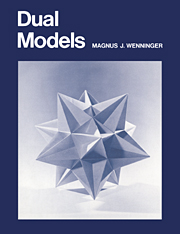Book contents
- Frontmatter
- Contents
- Foreword by John Skilling
- Preface
- Introduction
- I The five regular convex polyhedra and their duals
- II The thirteen semiregular convex polyhedra and their duals
- III Stellated forms of convex duals
- IV The duals of nonconvex uniform polyhedra
- V Some interesting polyhedral compounds
- Epilogue
- Appendix: Numerical data
- References
- List of polyhedra and dual models
- Frontmatter
- Contents
- Foreword by John Skilling
- Preface
- Introduction
- I The five regular convex polyhedra and their duals
- II The thirteen semiregular convex polyhedra and their duals
- III Stellated forms of convex duals
- IV The duals of nonconvex uniform polyhedra
- V Some interesting polyhedral compounds
- Epilogue
- Appendix: Numerical data
- References
- List of polyhedra and dual models
Summary
You may have noticed that none of the prisms or antiprisms have been presented in this book. These are also classified as uniform polyhedra, because for these, all the faces are composed of regular polygons, and all the vertices are alike. Why are they omitted? I would say merely because I personally do not find these shapes particularly attractive or interesting. But a complete presentation of duals for uniform polyhedra should really take these into consideration. The n-gonal prisms have duals that become n-gonal dipyramids, and the n-gonal antiprisms have duals that become n-gonal antidipyramids. You are invited to investigate their shapes by consulting the available literature on this topic. It certainly has its own mathematical value; so it is worth any attention you may want to give to it.
You may also want to go far more deeply into the mathematics of polyhedral shapes, more deeply than was done in this book. I have deliberately limited the level of mathematics so that it might come within the realm of knowledge attainable by most people. But the tools of higher mathematics can be used, and in fact have been used and undoubtedly will continue to be used in the study and investigation of polyhedra, not only in three-dimensional space but also in the study of polytopes in higher dimensions.
Another major tool for further study and investigation is computer analysis.
- Type
- Chapter
- Information
- Dual Models , pp. 149Publisher: Cambridge University PressPrint publication year: 1983



